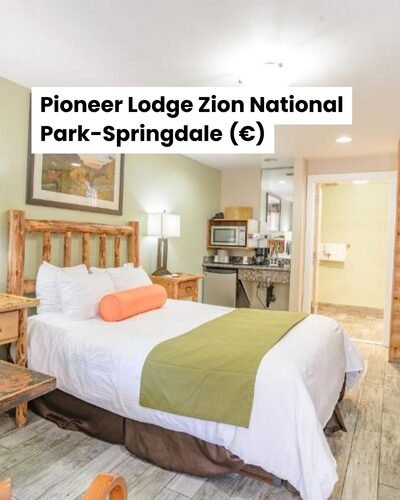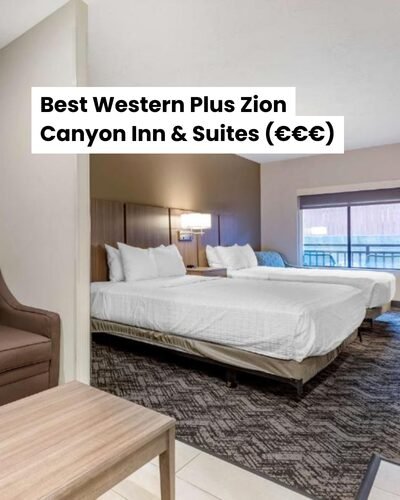Find out what to visit Zion National Park in one day: all the tips so you can plan your trip to the US’s third most visited national park.
Visiting Zion National Park is on the bucket list of anyone who wants to visit the national parks in the United States. After all, this is one of the most visited parks in the country and you quickly realise why.
Founded in 1919, Zion National Park is the third most visited park in the United States, with more than 4.5 million visitors in 2023.
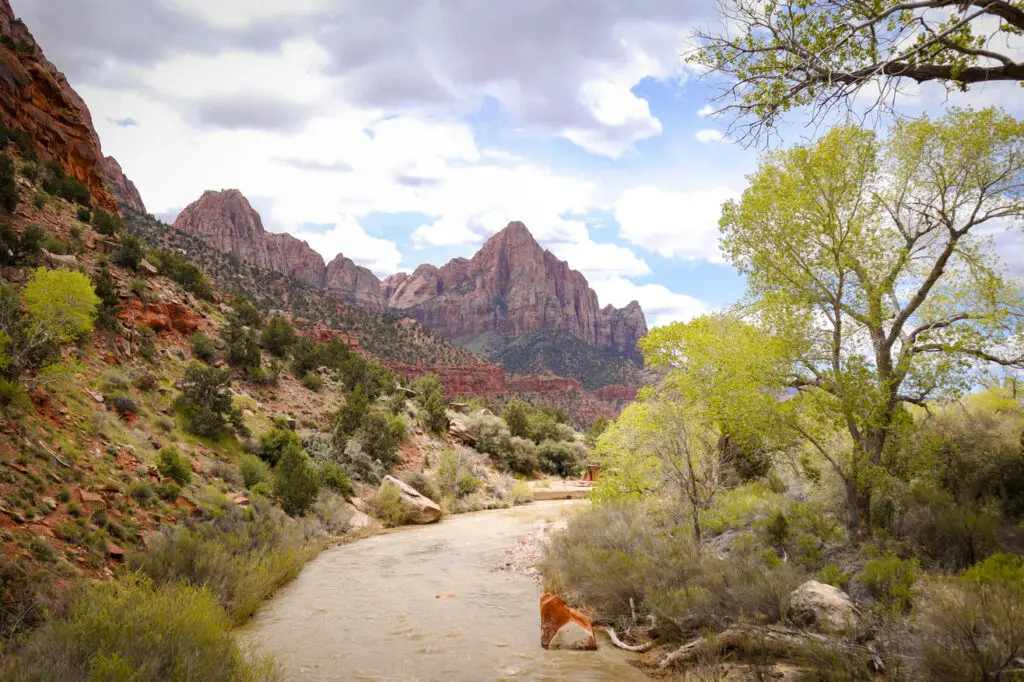
The park is in Utah and is quite a paradise for those who love hiking trails and walks in nature. There are trails for everyone: from one of the most challenging trails in the USA (Angels Landing) to hikes that are suitable for the whole family (e.g. Riverside Walk).

You can visit the main highlights of Zion National Park in just one day, but the park is so beautiful that you’ll certainly want to stay longer. This is a very complete destination, with lots to see and appealing to all types of travellers.
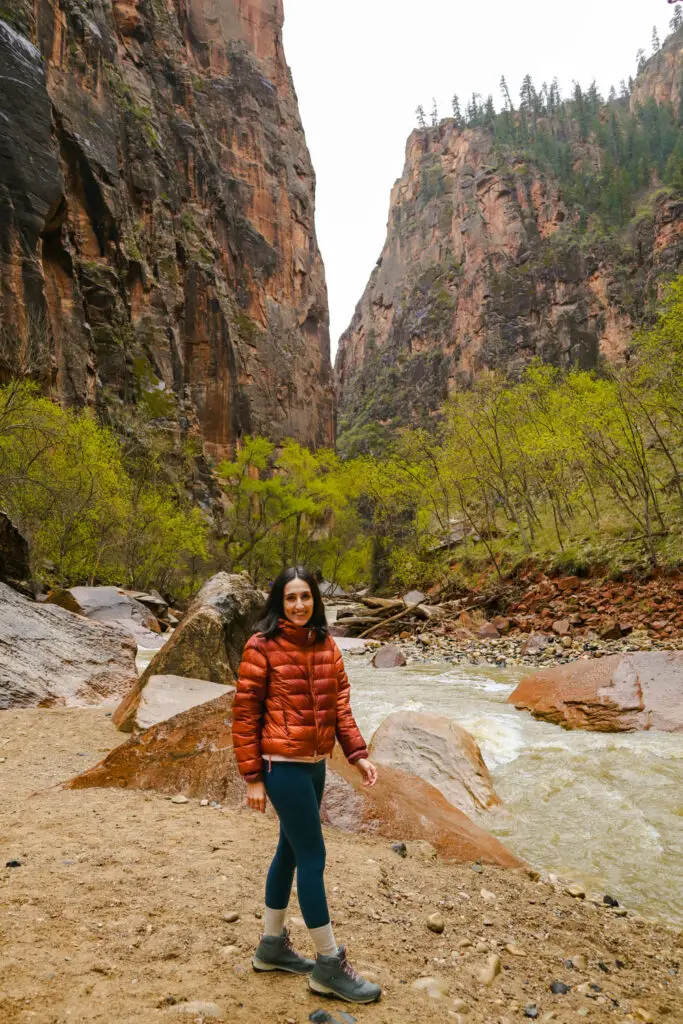
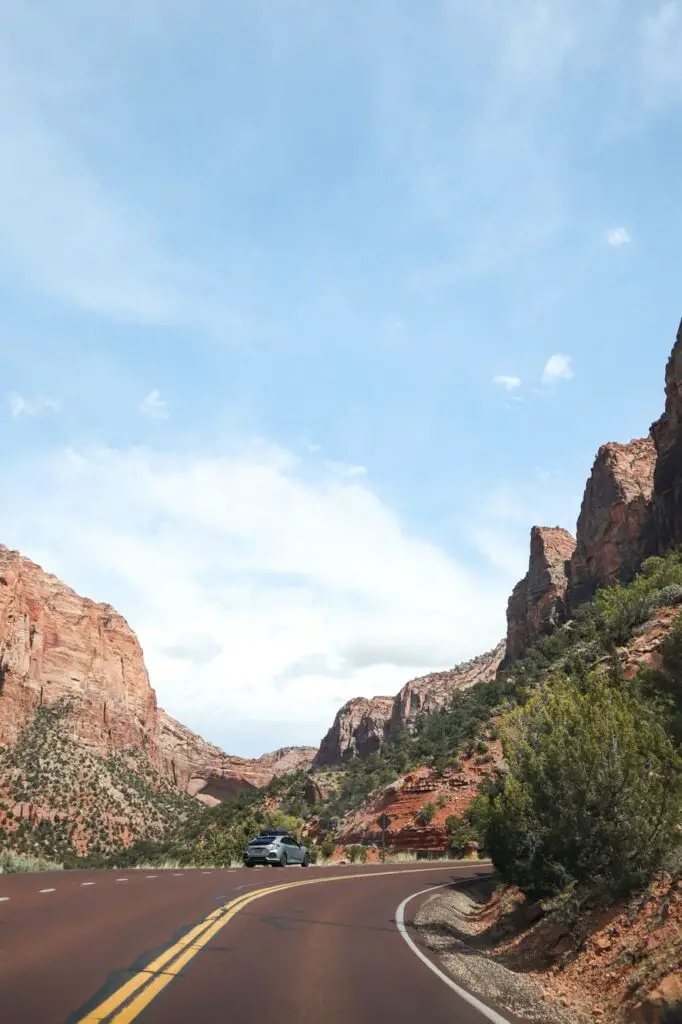
The park is divided into two parts: the Zion Canyon Scenic Drive and the Kolob Canyons. The first part is the most popular with visitors and is the road that connects the Visitor Centre to the Temple of Sinawava. The best trails in the park are accessible via this road. In the Kolob Canyons part, there is also a Visitor Centre and some trails, but this is a smaller area with less tourism.
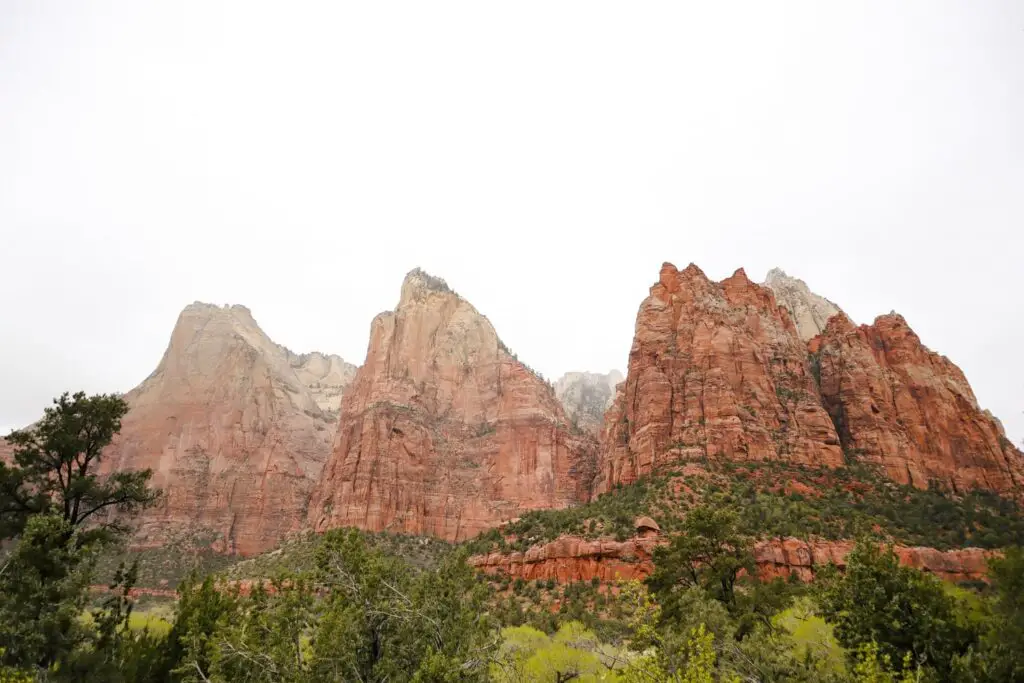
Planning a trip to Zion National Park can seem like a daunting task at first glance, as there are so many things to consider. So, throughout this post, in addition to an itinerary for Zion National Park, you’ll also find other useful information, such as:
- Best time of year to visit Zion National Park
- How many days in Zion National Park
- How to get to Zion National Park
- Zion National Park Hiking Trails
- Best way to get around the park
Where is Zion National Park?
Zion National Park is located in the south of the state of Utah. The nearest town to Zion National Park is Springdale. However, the best-known city in the United States that is closest to the park is Las Vegas. The car journey between Las Vegas and Zion National Park takes about 2h30.

However, there are other towns near Zion National Park, such as (below you’ll find how long the drive between each town and the park is):
- Hurricane Valley – 30 minutes
- St. George – 45 minutes
- Kanab – 45 minutes
- Cedar City – 1 hour
- Brian Head – 1h20
- Parowan – 1h30
Is Zion National Park worth a visit?
Zion National Park is one of those parks that deserves to be visited once in a lifetime! The park has incredible landscapes and is an excellent option for any type of traveller: from the more adventurous who enjoy a challenging trail to those who prefer a quieter and easier walk in nature.
How many days to spend in Zion National Park?
Although the park isn’t huge (607 km², 150.000 acres), the list of things to do in Zion National Park is extensive, with the main attractions involving trails. So the ideal length of a visit to Zion National Park depends very much on the trails you want to hike.
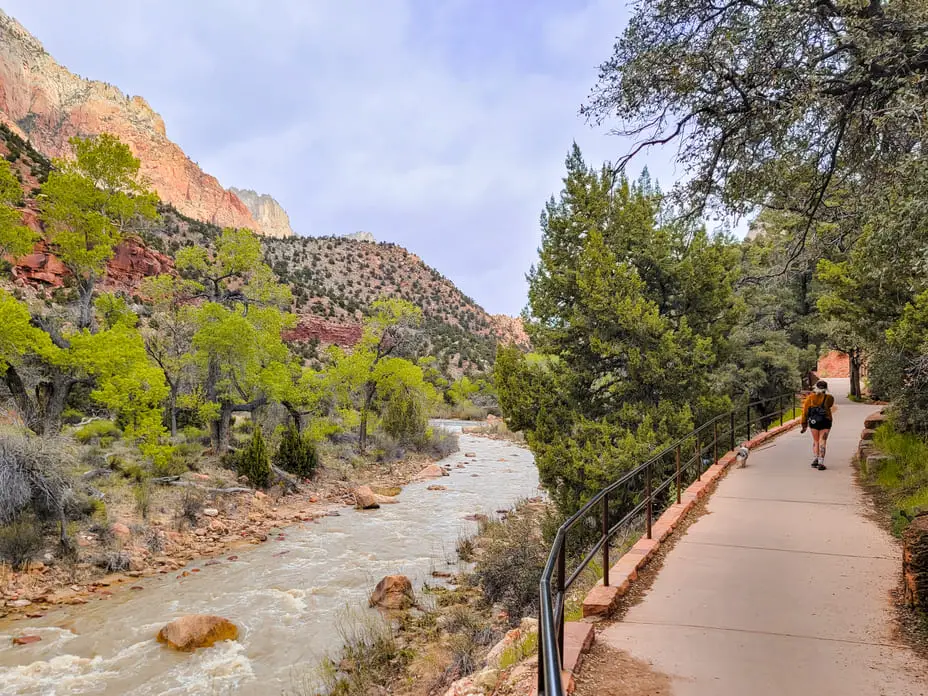
There’s a lot of offer and some of the trails are demanding and long, so the length of your visit will depend on the trails you choose. For example, if you choose to do two of the most famous trails (The Narrows and Angels Landing), I recommend at least two days in the park.
So I suggest you first choose which trails you want to do and adjust the number of days you need in the park accordingly.


In my case, I only spent one day in the park, so I didn’t hike Angels Landing or The Narrows. One day was enough to do some of the smaller trails and visit the main points of interest in Zion National Park.
However, if possible, I would recommend 1-2 days for a first visit to Zion National Park.
💡 EXTRA TIP: Sometimes trails close temporarily (very common at The Narrows) and so, closer to the date of your visit, it’s a good idea to check the status of each trail you intend to hike on the official Zion website. This information is updated frequently on the site and is available right on the home page.
When is the best time to visit Zion National Park?
Zion National Park can be visited at any time of the year. The weather in Zion National Park varies throughout the year, with cold winters (lows around 0 °C/32 °F, highs around 10 °C/50 °F) and summers tend to be hot, with temperatures often exceeding 35 °C/95 °F during the day in the hottest months. You can find out more about the climate in Zion National Park here.
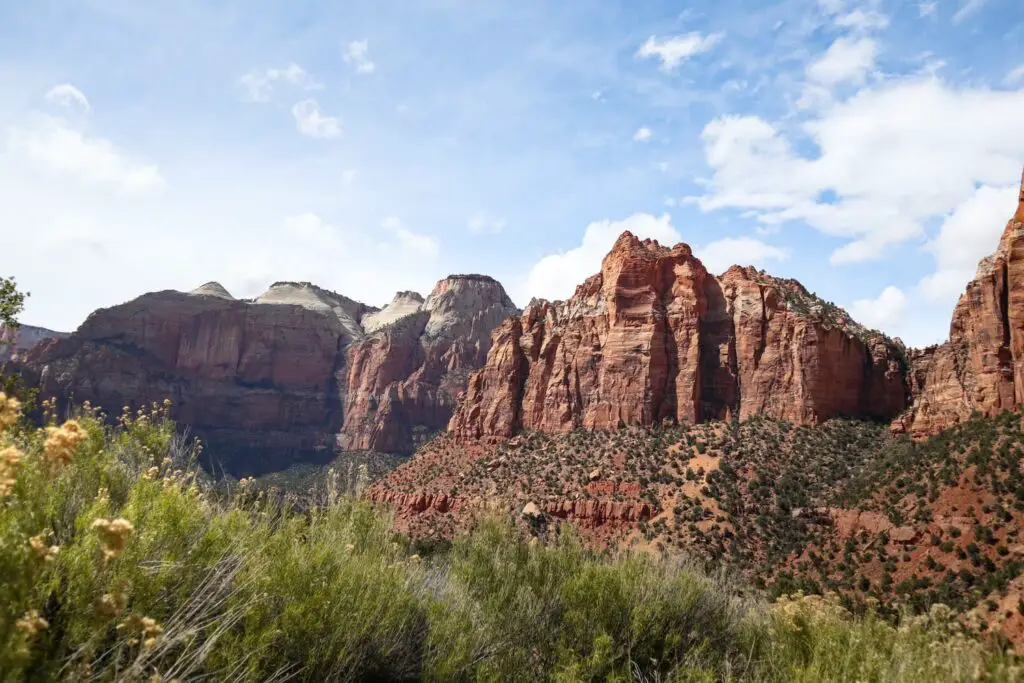
Spring and early autumn are two of the best times to go to Zion National Park, as the temperatures are milder (although the nights are colder) and you’ll find fewer tourists. In fact, September and October are probably the best times to visit Zion National Park to avoid crowds.
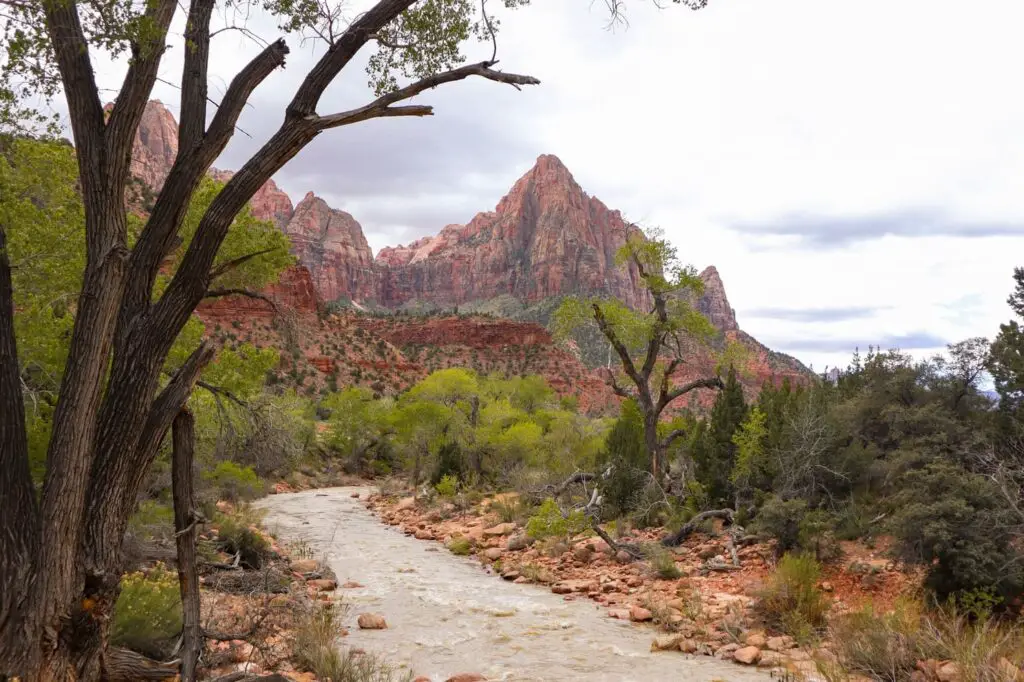
In my case, I visited the park in mid-April. It was cold and a rather grey day, but even the rain couldn’t hide the park’s beauty. In terms of crowds, the park already had quite a few visitors, but nothing extraordinary.
💡 EXTRA TIP: Although spring is an excellent time of year to visit the park, due to the flow of the Virgin River, the Narrows trail is often still closed in March and April. This trail usually opens in May, but this can vary from year to year. It’s therefore important to check the official website for updates on this trail.
Finally, visiting Zion National Park in winter will allow you to see it differently as it may snow, but this can also be one of the most challenging times to visit. Temperatures are low and snow and ice can make some trails difficult to hike. However, the winter months have some advantages such as not having to ride the shuttle, as the Zion Canyon Scenic Drive is open to private vehicles.
How much is the ticket entrance to Zion National Park?
You have to pay to enter Zion National Park. There are various entrance tickets and passes available. For example, entrance fees with a private vehicle are 35 USD (the price is per vehicle, not per person). This entrance fee gives you access to the park for 7 days! There is also an annual pass which costs 70 USD.
However, if you wish to visit other national parks in the United States, other options are more worthwhile. One such example is the America the Beautiful annual pass. This pass costs 80 USD per vehicle and is valid for one year for all the national parks in the country. Given the average price of entry to the various parks, you only need to visit 3 national parks in a year to make it worth buying America the Beautiful! More information about the passes is available here.
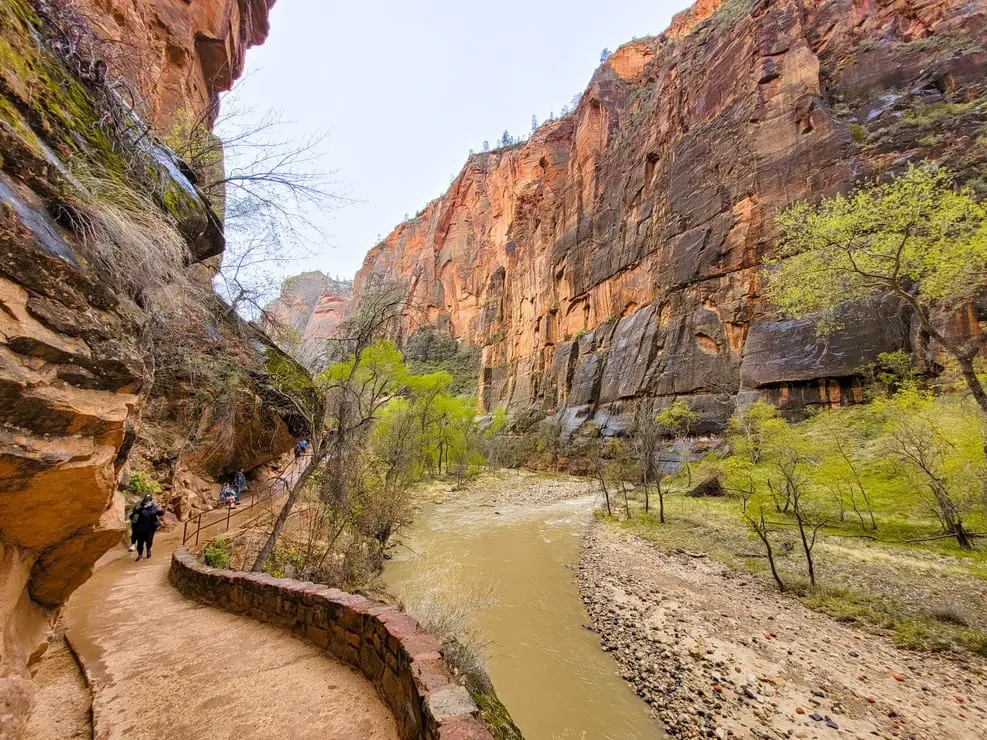
Any of these tickets or passes can be bought at the entrances to the various national parks. I should warn you, however, that some entrances/parks may only accept card payments. At Zion National Park, they accept both cash and cards. You can also buy your entrance tickets online if you wish to spend less time queuing to enter the park😉. Even though it might reduce the time in the queue, you’ll always have to show the pass the enter the park, which can also take some time during peak season.
If you choose to buy the America the Beautiful annual pass, once you’ve bought it, you’ll need to show your pass and ID when entering each park, as the pass is non-transferable.
Is there mobile network in Zion National Park?
The mobile network in Zion National Park is quite limited, so you should be prepared for no internet access. Therefore, I strongly suggest downloading the map of the park area to be available offline on Google Maps.
Alternatively, there is wifi in the park, at the Visitor Centre and the Human History Museum. However, this is a paid service.
How to get to Zion National Park?
The closest airport to Zion National Park is St George’s (SGU), which is about 75 km/47 mi by car from the park’s main entrance (about a 1-hour drive). However, this is a regional airport, so it only has a few direct connections with other cities in the United States, such as Los Angeles, Salt Lake City, Phoenix or Denver.
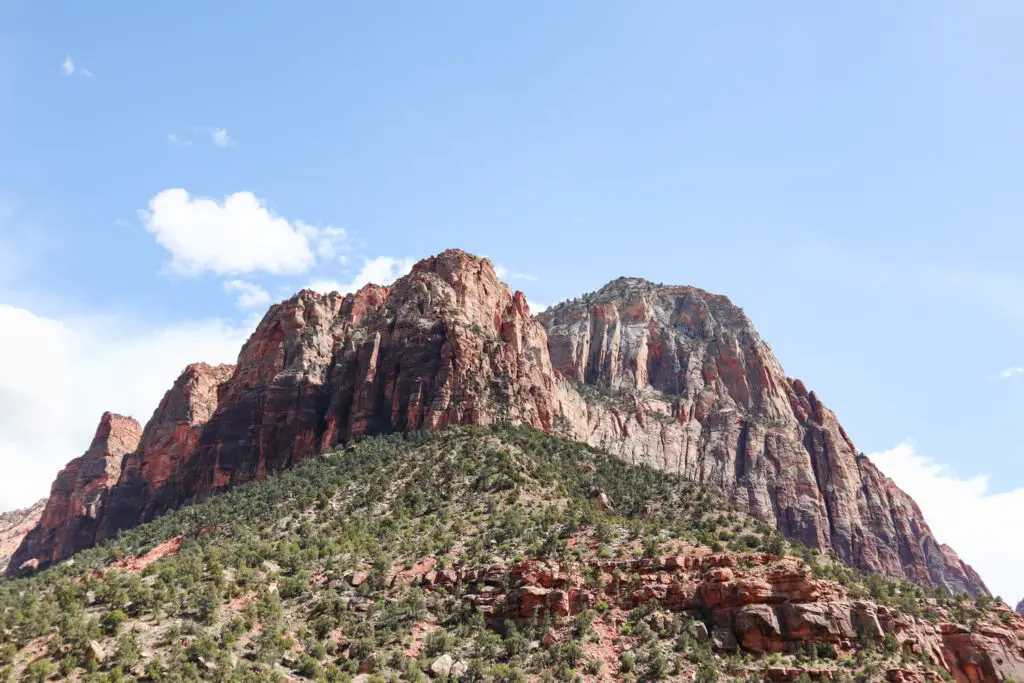
So it might make more sense to fly to Las Vegas, which is an airport with many international connections all over the world, and from there rent a car to go to Zion National Park. The journey from Las Vegas to Zion National Park is about 2h30.
Renting a car is an excellent option, as it gives you more flexibility in your itinerary. However, if you don’t feel comfortable doing so, there are some tours to Zion National Park from Las Vegas:
For example, this tour departs from Las Vegas and passes through some of the best things to do in Zion National Park.
Entrances of Zion National Park
There are 4 possible entrances to Zion National Park:
- Through Springdale: this is the most popular entrance (if you’re coming from Las Vegas, this is where it makes the most sense to enter the park)
- Through Zion-Mount Carmel Road: the second most popular entrance, on the east side of the park
- Through Kolob Canyon: the entrance is located on the west side of the park on the I-15 motorway
- Through Kolob Terrace Road: it’s not an official entrance, but it’s close to the town of Virgin and also gives access to the park
What is the best way to visit Zion National Park?
Given the popularity of Zion National Park, for much of the year, the Zion Canyon Scenic Drive is closed to private vehicles, but a shuttle bus runs along this route. Using the shuttle is included in the park’s entrance ticket and no reservation is needed.
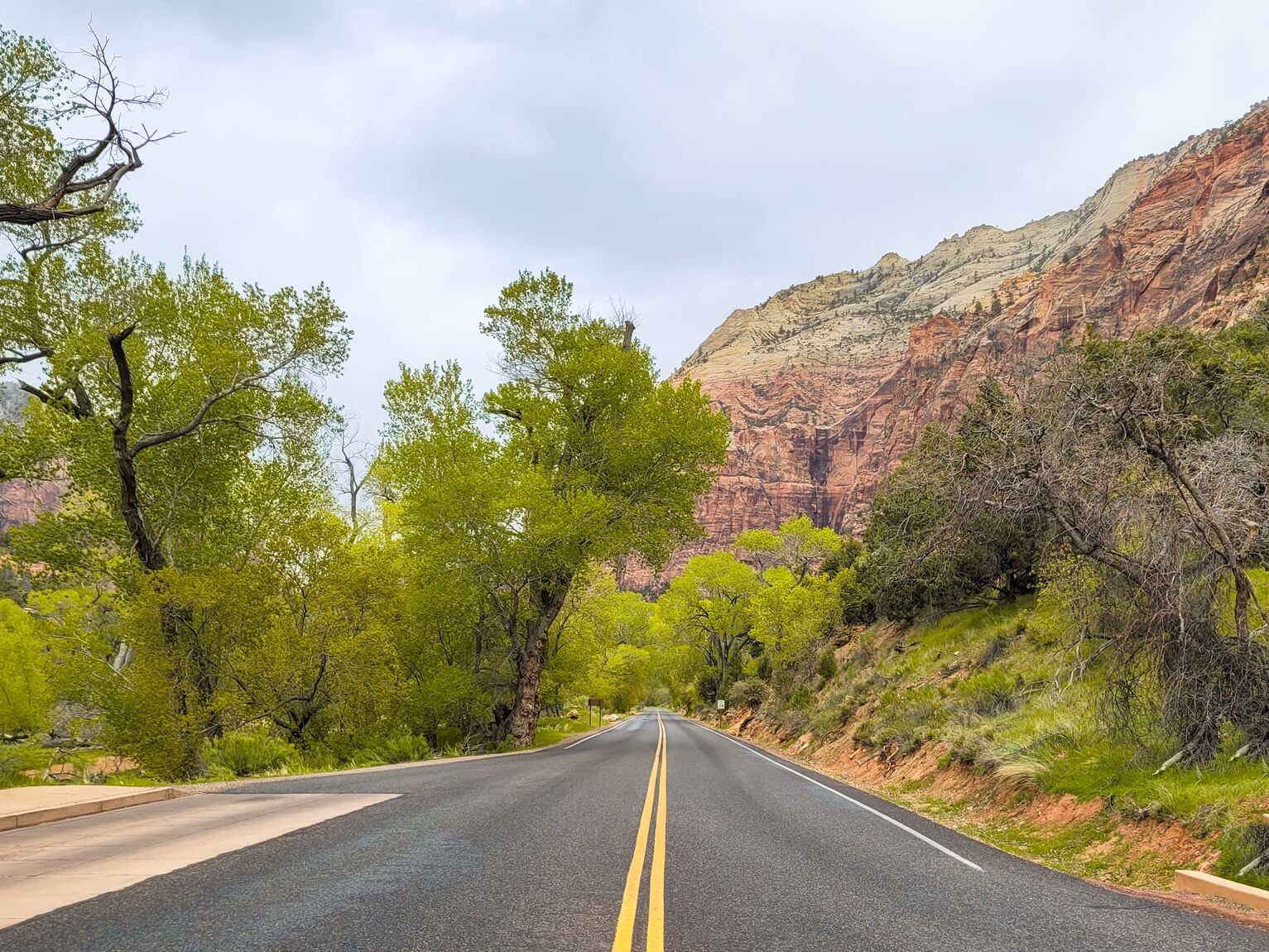
In any case, the most practical way to visit Zion National Park is by car, as the shuttle only runs in specific areas of the park. For example, to drive on the magnificent Zion-Mt. Carmel Highway, you’ll need a car. A “normal” vehicle will do the job, you don’t need a 4×4.
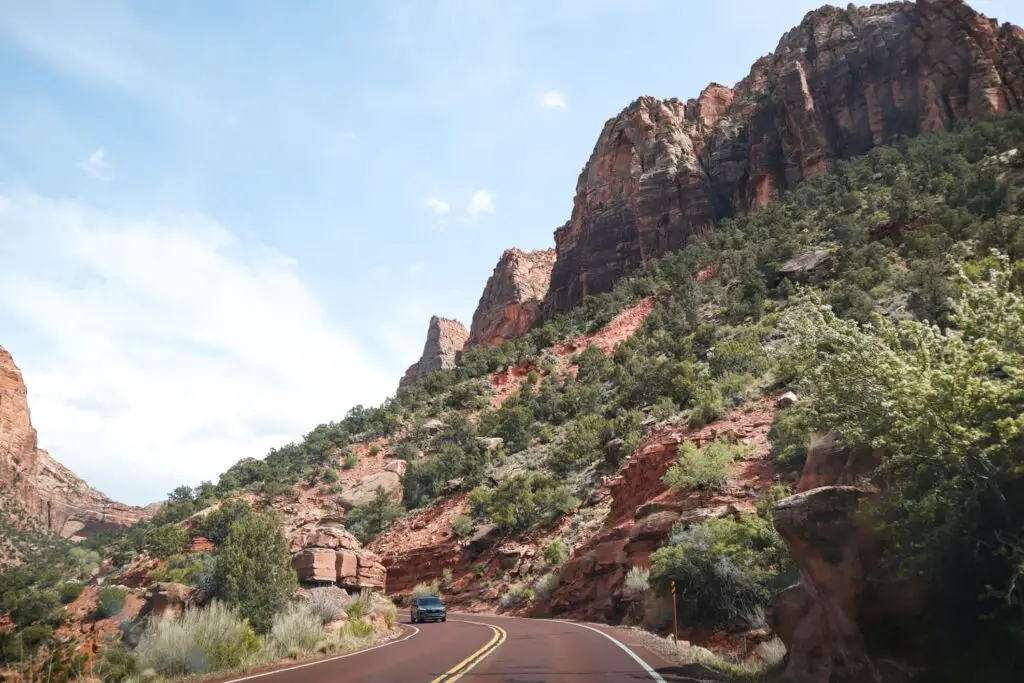
If you visit the park in winter (January to early March) and the Zion Canyon Scenic Drive is not closed to private vehicles, I suggest you try to start your visit as early as possible, as parking is very limited along this road.
💡 EXTRA TIP: When I visited Zion National Park, I was doing a road trip through other national parks in the United States. There’s no doubt that renting a car was the best option, as it gave me a lot of freedom to prepare my itinerary. I rented a Toyota RAV4 from Avis in Los Angeles and really enjoyed their service. Although I didn’t need this feature for what I visited in Zion National Park, I paid a bit more and decided to rent a high-clearance vehicle, which is an excellent option if you want to drive on some of the dirt roads that exist in the US national parks.
How does the shuttle work?
These are the 2 shuttle lines in Zion National Park:
- Zion Canyon Line Shuttle: shuttle bus located inside the park that connects the Visitor Centre to the Temple of Sinawava.
- Springdale Line Shuttle: Located outside the park, this line connects some of the main lodgings in Springdale to the visitor centre. This route is drivable all year, even during peak season when other roads close in the park
The Zion Canyon shuttle runs every 5 to 10 minutes, while the Springdale shuttle runs every 15 minutes.
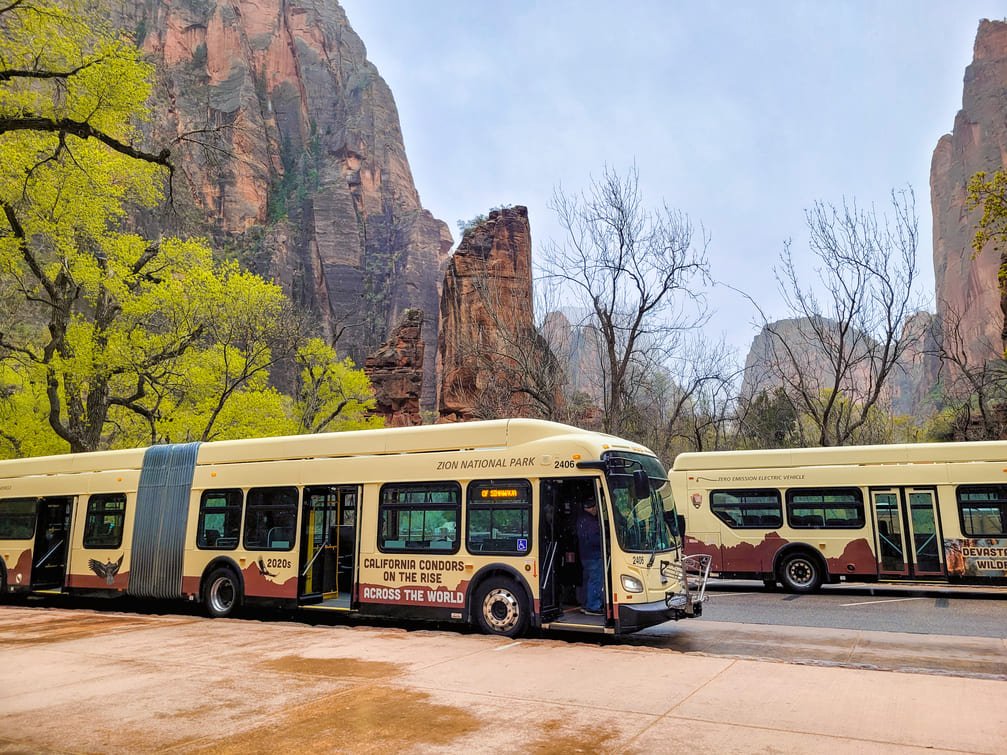
The journey between the first and last stops of the Zion Canyon shuttle takes around 45 minutes. This service operates from March to September (and also during the holiday period in December) and the opening hours vary depending on the time of year. As timetables can change, I recommend checking the most up-to-date timetables for both shuttles beforehand.
💡 EXTRA TIP: Pay attention to the departure times of the last shuttles of the day, as once they have finished their daily service, the only option for returning to the car is to walk. For example, from the last stop (Temple of Sinawava) to the Visitor Centre, it takes about 2h45 on foot.
When I visited, some of the shuttle stops were temporarily closed. The driver informed passengers about these closures and the possible alternatives for accessing the various points of interest in the park. Anyway, I’m sharing a map of the Zion Canyon line to help you plan a trip to Zion National Park.

All the most up-to-date information on the operation of the Zion National Park shuttles (including up-to-date maps) can be found on the official website.
Although the maps are very intuitive and it’s easy to see which stop to use for the various points of interest inside the park, I suggest you study beforehand which stops you want to get off at to optimise your itinerary. For example, if you choose to do Angels Landing, I suggest you go straight to stop #6 (The Grotto) in one of the first shuttles of the day, as this is one of the most popular places in the park.

Another crucial tip for the busiest months (June to September) is to try to start exploring the park early, using one of the first shuttles available. The shuttle operates on a first-come, first-served basis and, in the months with the most visitors, you can easily spend more than 1h waiting to get into a shuttle. And why wait so long in a queue when there are so many wonderful things to visit in this park? 😁
Parking at Zion National Park
At the entrance near Springdale, there are several parking spaces. If you arrive at the park early enough (before 9 am), I suggest parking your car next to the Visitor Centre and getting on the Zion Canyon Scenic Drive shuttle there.
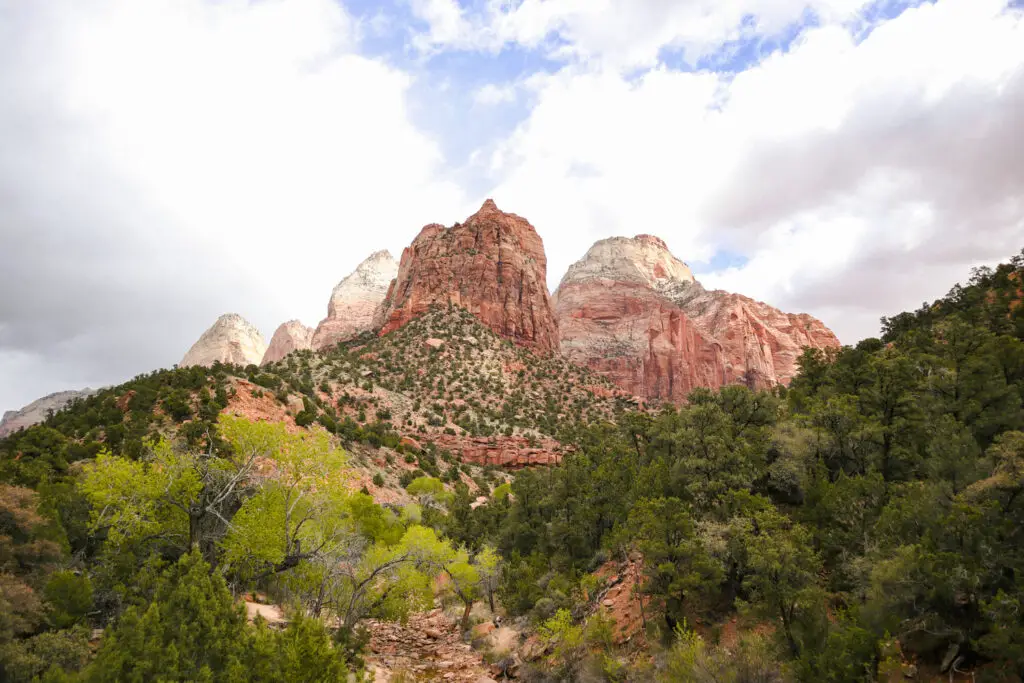
However, if you arrive a bit later or visit the park in the summer months, I suggest parking your car in Springdale and using the shuttle line that connects Springdale to the Visitor Centre. The car parks in Zion National Park are large, but not big enough during the busiest months.
Even in the low season, when you can drive on the Zion Canyon Scenic Drive, parking spaces are quite limited, so it’s important to bear this in mind when planning your trip.
Accommodations in Zion National Park
Accommodation inside Zion National Park
There is only one lodge inside the park – Zion National Park Lodge. As this is the only lodge located inside the park, it quickly runs out of available rooms, especially during the busiest months. So if you’re planning to stay here, I suggest you book your accommodation as far in advance as possible.
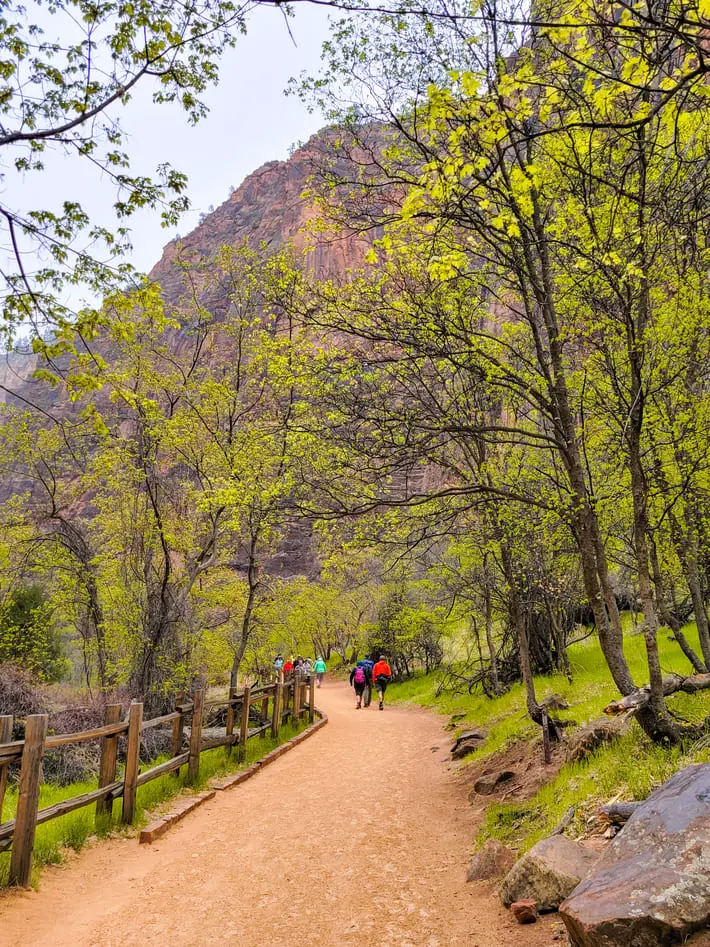
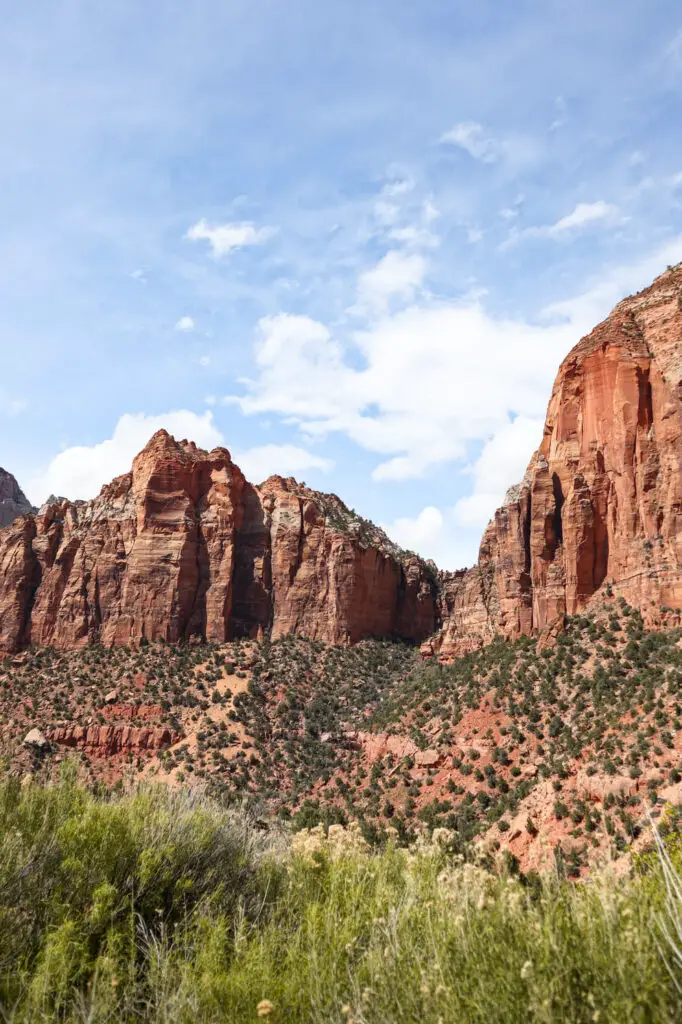
Guests at Zion Lodge have special authorisation to drive on the Zion Canyon Scenic Drive, even during the months when it is closed to private vehicles. In addition, there is a shuttle stop in front of Zion Lodge, making it easy to get around the park.
Another option for accommodation inside the park is the campsites in Zion National Park. There are 3 campsites:
- Watchman Campground: open all year round and should be booked in advance
- South Campground: currently closed for a rehabilitation project
- Lava Point Campground: there is always a need for reservation
Accommodation near Zion National Park
Since accommodation options inside Zion National Park are scarce and often expensive, the second best option for looking for accommodation near Zion National Park is the town of Springdale, which is just outside the park. There are several accommodation options here, so here are a few suggestions:
However, given Springdale’s convenient location, you’re most likely to find much cheaper accommodation if you look a bit further away from the park. For example, in my case, I chose to stay in the town of St. George, located about a 1-hour drive from the Zion National Park Visitor Center (near Springdale).

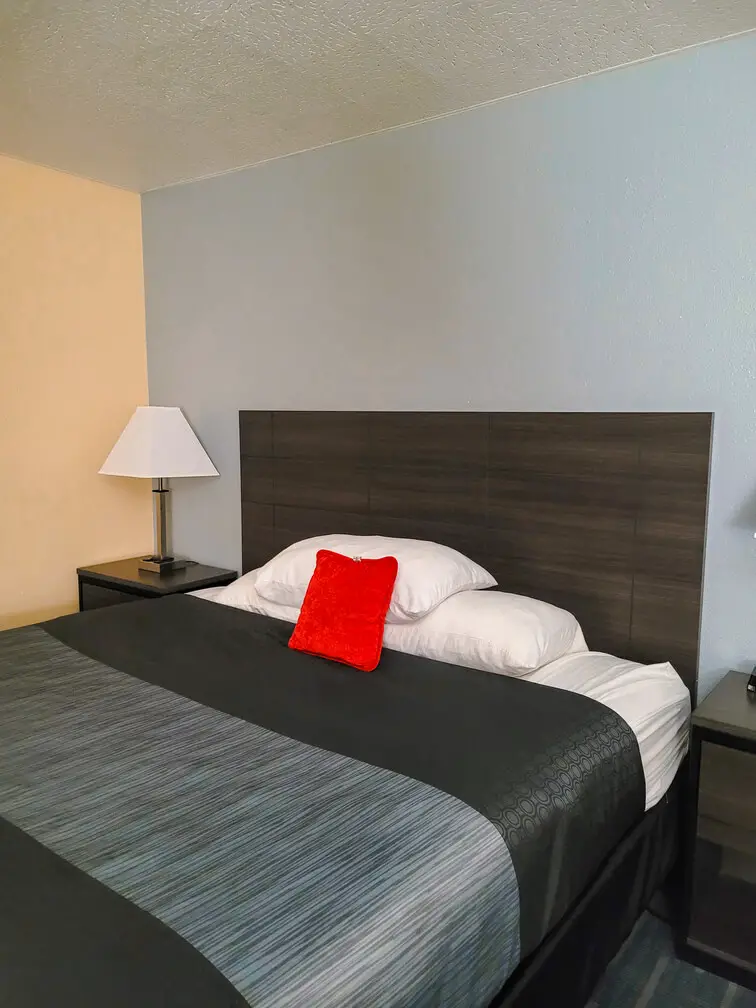
The hotel I stayed in – the Red Lion Hotel & Conference Centre – was a bit old-fashioned, but it was clean and breakfast was included (although it wasn’t anything special). What’s more, it was very affordable (52€ a night for 2 people).
Is it possible to buy food inside Zion National Park?
Unlike other parks in the United States, it is possible to buy food and have meals inside Zion National Park, near the Zion Lodge, either at the Castle Dome Café (seasonal service) or at the Red Rock Grill.
However, close to the Visitor Centre (although technically outside the park), several options can be reached on foot, such as:
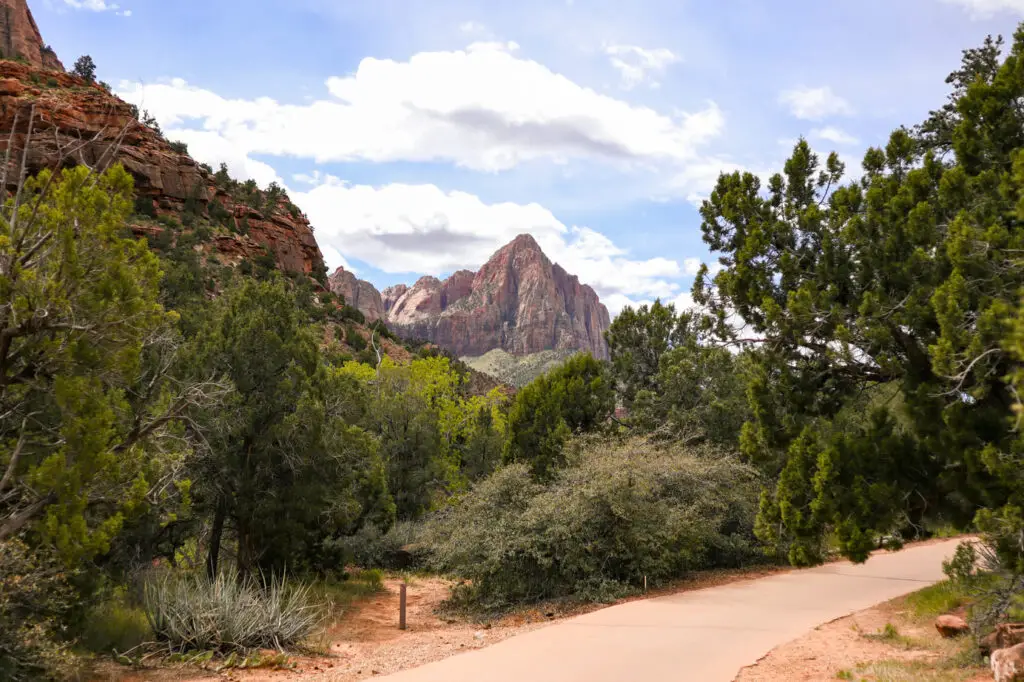
There are even more options in the centre of Springdale, but most require a car as they are further away. Honestly, my recommendation is to pack lunch to maximise your time in the park. This is what I did when I was in Zion National Park (and in almost every park I’ve visited in the US 😁) and I couldn’t recommend it more. After all, it’s not every day that you can have lunch with such a beautiful backdrop.
💼 TRAVEL INSURANCE: Unexpected events happen anywhere in the world, so I always recommend getting travel insurance. I regularly use Heymondo, which offers some of the highest coverages on the market at very competitive prices. As well as covering medical expenses, Heymondo’s insurance also covers the loss or theft of luggage, electronic equipment and more. They also have a 24/7 customer service through their App. As A Ticket to Take Off reader, you get a 5% discount when purchasing Heymondo insurance. The purchase must be made using this link, and the price shown on the website already includes the discount.
Activities & tours in Zion National Park
Best things to do in Zion National Park – Map
To help you plan your trip to Zion National Park, I’ve put together its main points of interest on a map, divided into what you can visit in one day and more attractions in the park for those who have more days available.
On the map, you can also see the location of the various Zion Canyon line shuttle stops.
📌HOW TO USE THE MAP: Click on the top left corner to access the various layers of the map. You can select the layers you’re interested in and also find out more about each point of interest by clicking on it in the left-hand sidebar or on the pin on the map. Add the map to your Google Maps by clicking on the star next to the title. To access the map, simply go to Google Maps ‘Saved’ and click on ‘Maps’!
Zion National Park in one day
Although it is possible to spend several days in this incredible park, this part of the article aims to give you tips on how to spend one day in Zion National Park. In one day, you can visit the park’s main attractions and hike one or two of the shorter trails.
Anyway, at the end of the post, you can also find other tips on what to visit if you have more time to spare, which includes some of the best Zion National Park’s hikes.
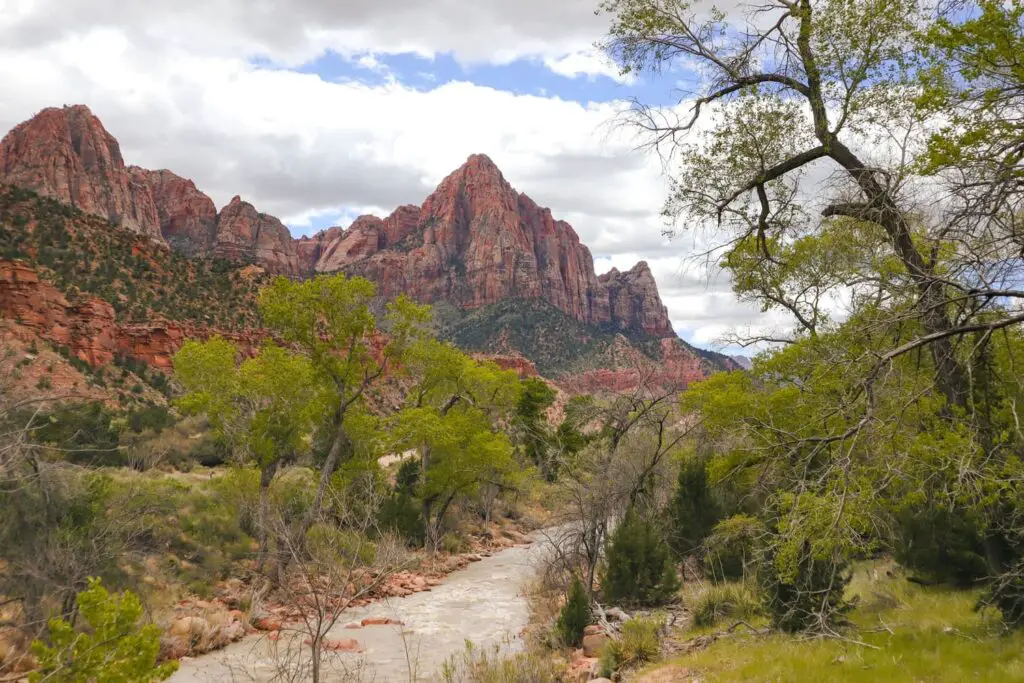
I suggest starting this Zion National Park itinerary with the points of interest along the Zion Canyon Scenic Drive, as this is the most popular part of the park. Taking one of the first shuttles of the day and starting at the stops further along the road (or at stop #6, where the Angels Landing trail begins) will save you some time waiting to get on the shuttle.
» Angels Landing
Let’s start with the most famous place in Zion National Park – Angels Landing. This is considered by many to be one of the most vertiginous trails in the United States and proof is that many people decide to do it not only for the fantastic views at the end of the trail but for the route itself.
Personally, I chose not to do this trail because, after seeing some pictures, I thought I would be too afraid of heights. However, as I know that this is one of the park’s main attractions, I decided to include it in this itinerary anyway. For more information on this trail, I recommend reading this article.
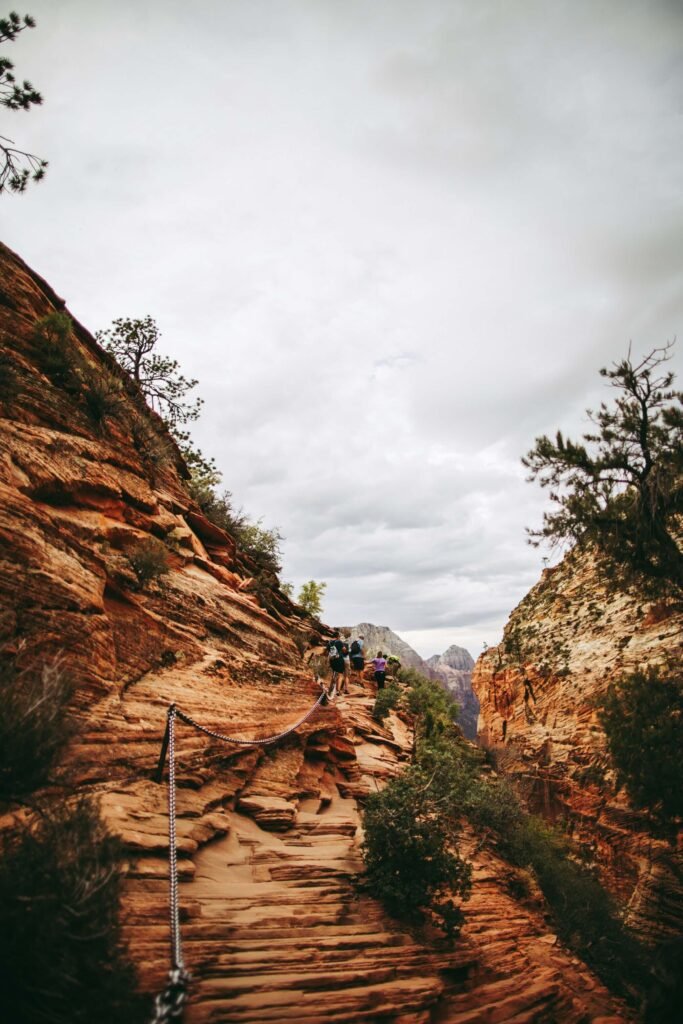
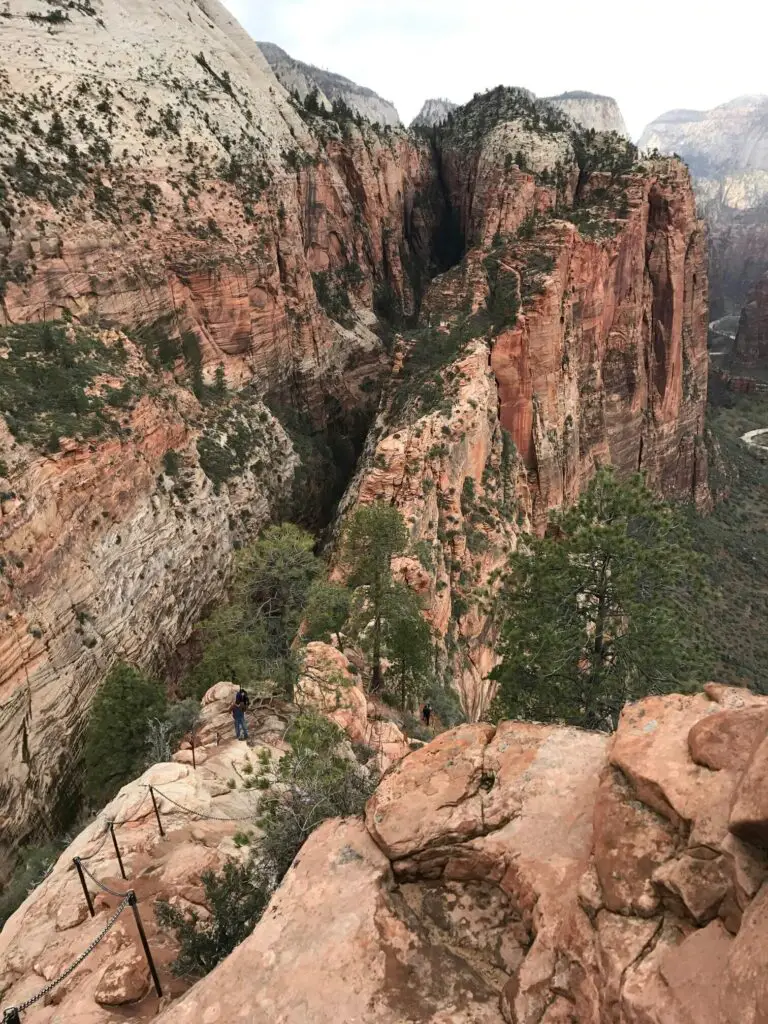
Since this is the main sight in the park, I suggest making this the first stop of the day to avoid the crowds. Moreover, you’ll be done with the most demanding trail of the day right away.
Given the demand for this trail and safety reasons, you need a permit to hike it. You can find all the information about permits to access Angels Landing on the official website.
Useful information about the Angels Landing trail:
- Shuttle stop: The Grotto (#6)
- Distance: 8,7 km (5,4 mi) out and back
- Difficulty: High
- Elevation: 457 m (1500 ft)
- Recommended duration: 3h
» Riverside Walk
Get on the shuttle again and head to stop #9 – Temple of Sinawava. This is where one of the easiest trails in Zion National Park begins and, consequently, this is one of the most popular with people of all ages and physical conditions.
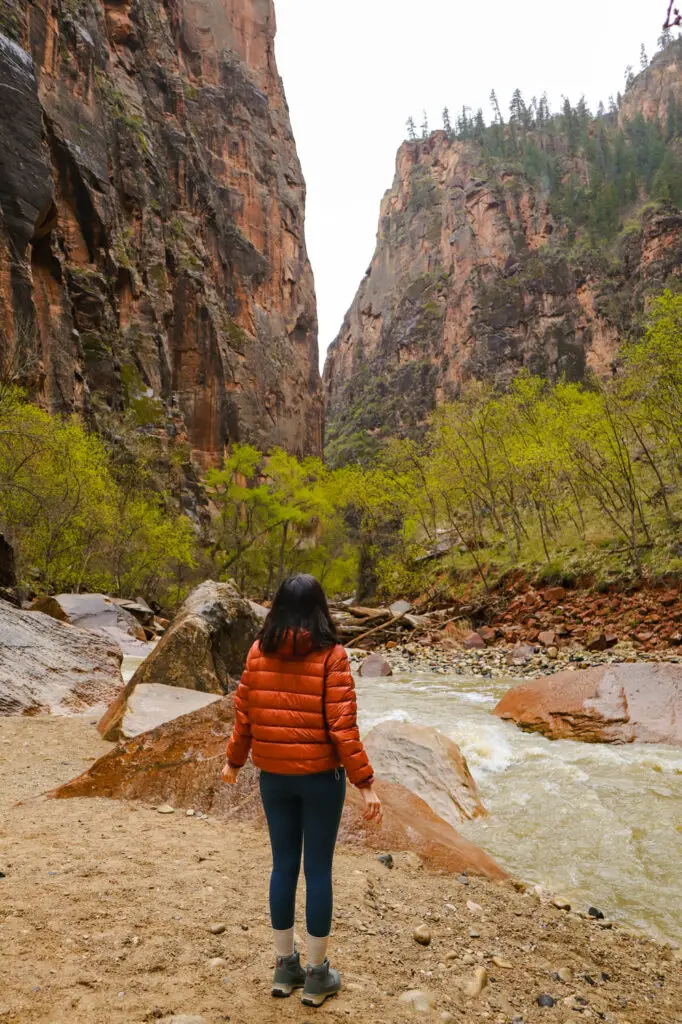

The Riverside Walk trail is mostly flat, running alongside the Virgin River. It’s a very pleasant trail and an experience suitable for all the family 🥰. When I visited, I saw deer and squirrels along the way.


Useful information about the Riverside Walk trail:
- Shuttle stop: Temple of Sinawava (#9)
- Distance: 3,5 km (2,2 mi) out and back
- Difficulty: Very easy
- Elevation: 17 m (57 ft)
- Recommended duration: 1h30
» Court of the Patriarchs
Taking the shuttle back to the Visitor Centre, you can get off at stop #4 for a quick visit to Court of the Patriarchs. This point allows us to admire the three patriarchs: Abraham, Isaac and Jacob. They are actually three mountain peaks that were given these names in 1916 by Dr Frederick Vining Fischer.
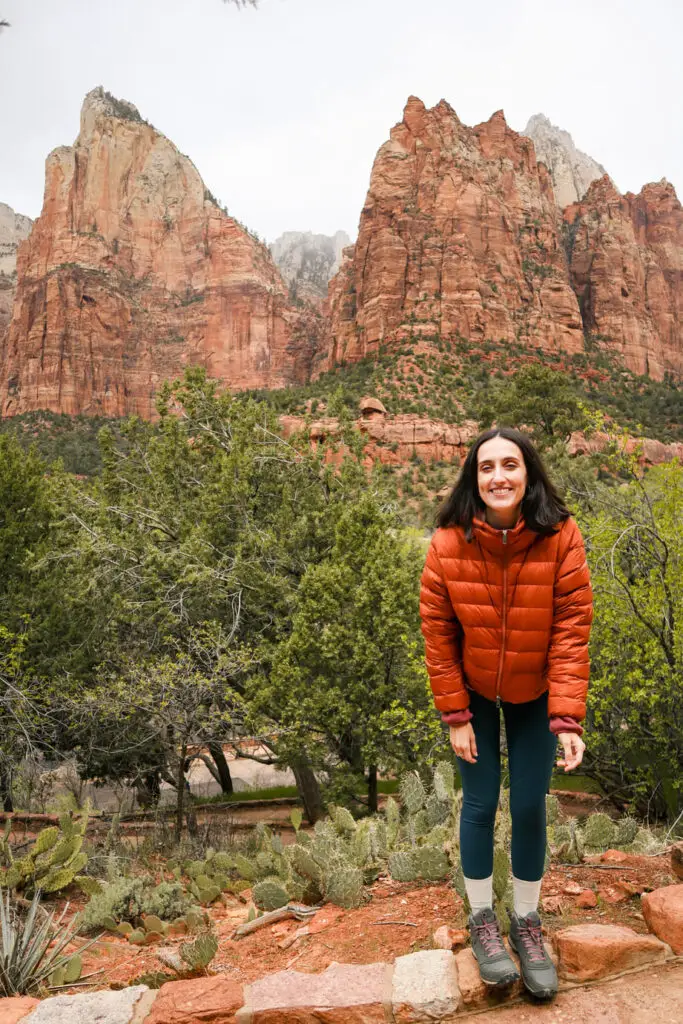

Although the summits are visible from the road, there is a small viewpoint that you can climb to. The route is very short but steep. The views from the viewpoint are even better!
» Canyon Junction Bridge
Get back on the shuttle and get off at the next stop (#3). Canyon Junction Bridge is one of the most photographed spots in the park and a must-see in any Zion National Park one-day itinerary.
Although it is possible to get here by car (even in the months when the road is closed to private vehicles), if you’re following this itinerary, it makes more sense to use the shuttle to visit this iconic place in the park. However, please note that the shuttle only stops at this stop when the shuttle is heading from the Temple of Sinawava to the Visitor Centre.
This is the perfect place to watch the sunset at Zion National Park, but honestly, it’s beautiful at any time of the day. Here you can gaze at the summit of Watchman and the Virgin River.
I don’t know if it’s something recent, but when I visited in April 2024, there was a sign indicating that it wasn’t possible to stop on the bridge.
» Pa’rus Trail
If you still have time and energy, you can return to the Visitor Centre via the Pa’rus Trail. This is a very pleasant and easy trail, located next to the Virgin River.

I confess that I didn’t even have this trail on my itinerary in Zion National Park, but I decided to do it while I was visiting the park. Except for the final part, which is a little more boring because the landscape isn’t that amazing, the trail was well worth it.
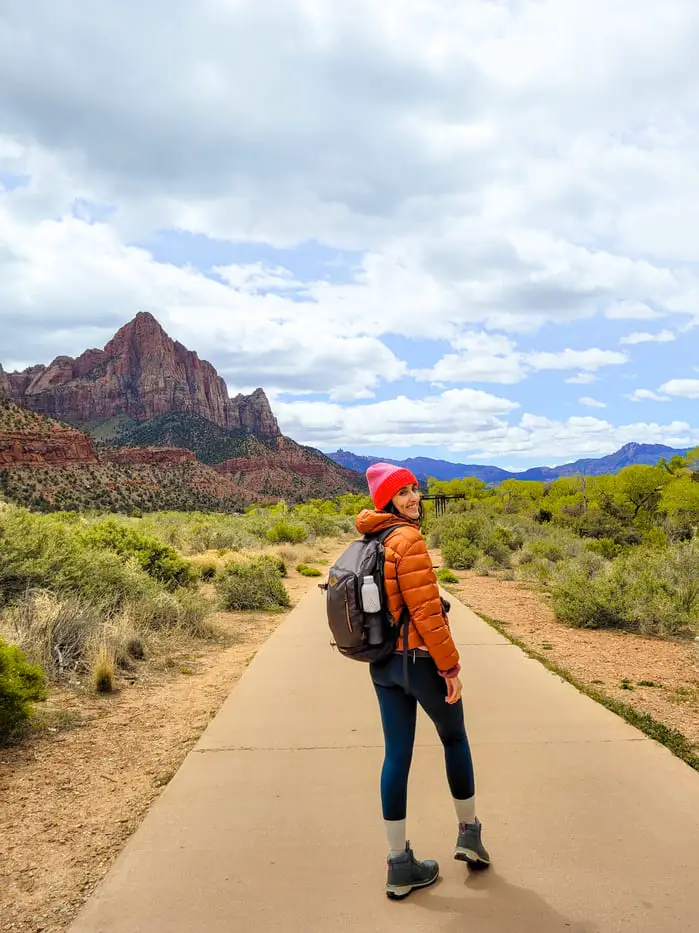
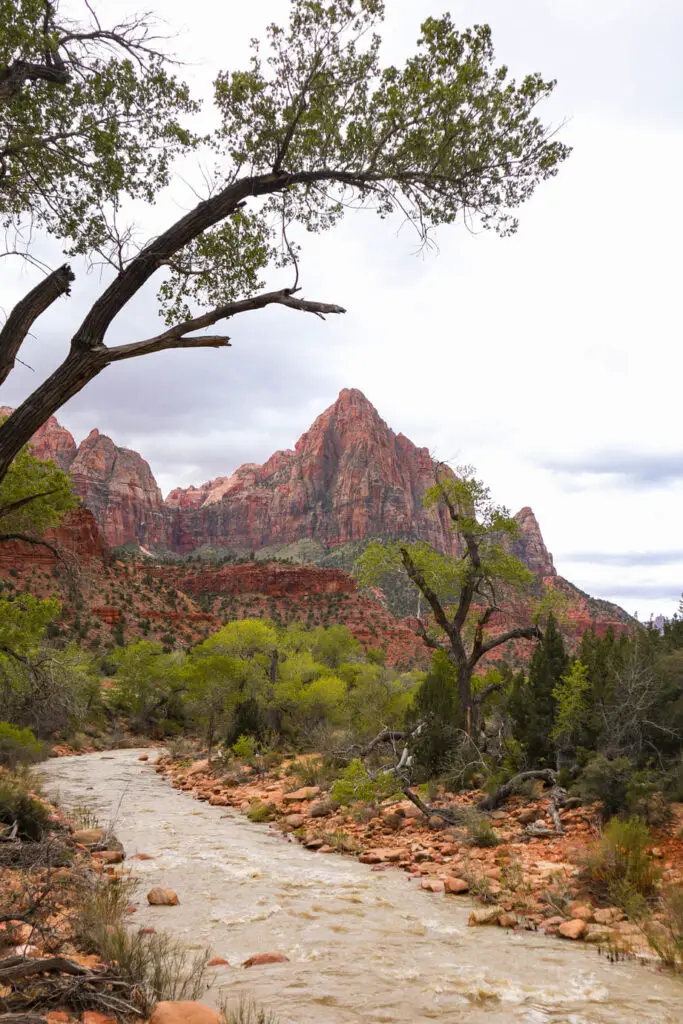
Useful information about the Pa’rus Trail:
- Shuttle stop: Canyon Junction (#3)
- Distance: 5,6 km (3,5 mi) out and back. However, if you do as I suggest, the trail is only 2.8 kilometres (1.8 mi).
- Difficulty: Very easy
- Elevation: 15 m (50 ft)
- Recommended duration: 2h. If you only do it in one direction, the trail takes about an hour.
💡 EXTRA TIP: Depending on the time you have available and whether you hiked Angels Landing, it might make sense to skip the Pa’rus Trail and use the shuttle to return to the Visitor Centre instead.
» Drive on Zion – Mt. Carmel Highway
Once you’ve returned to the Visitor Centre, you can get in the car, because it’s time to do another activity that should be on any list of what to do in Zion National Park in one day.
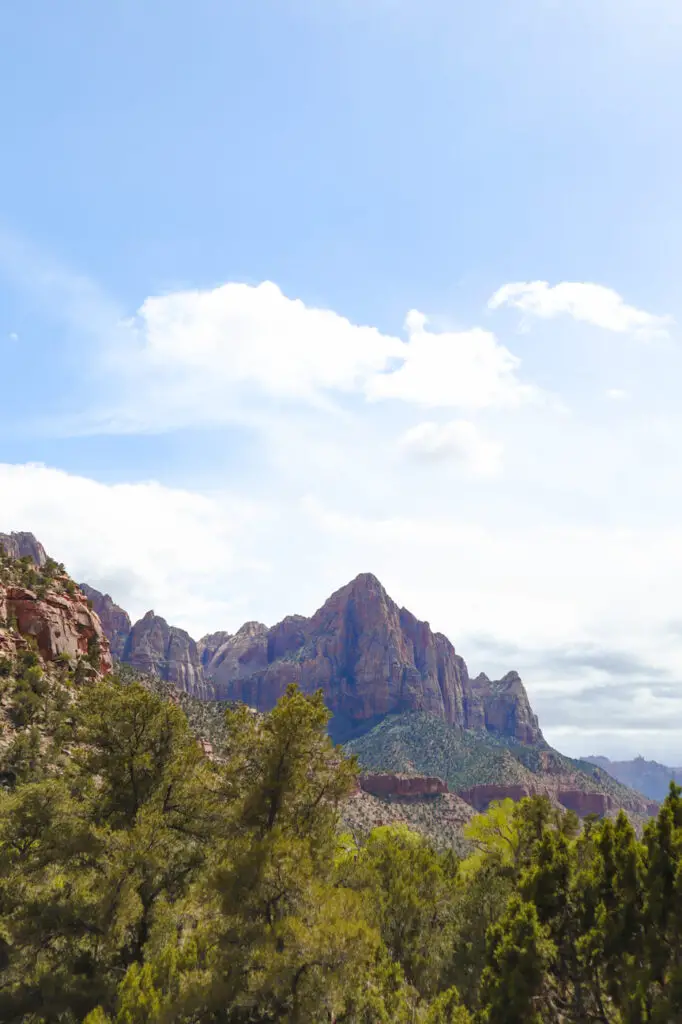
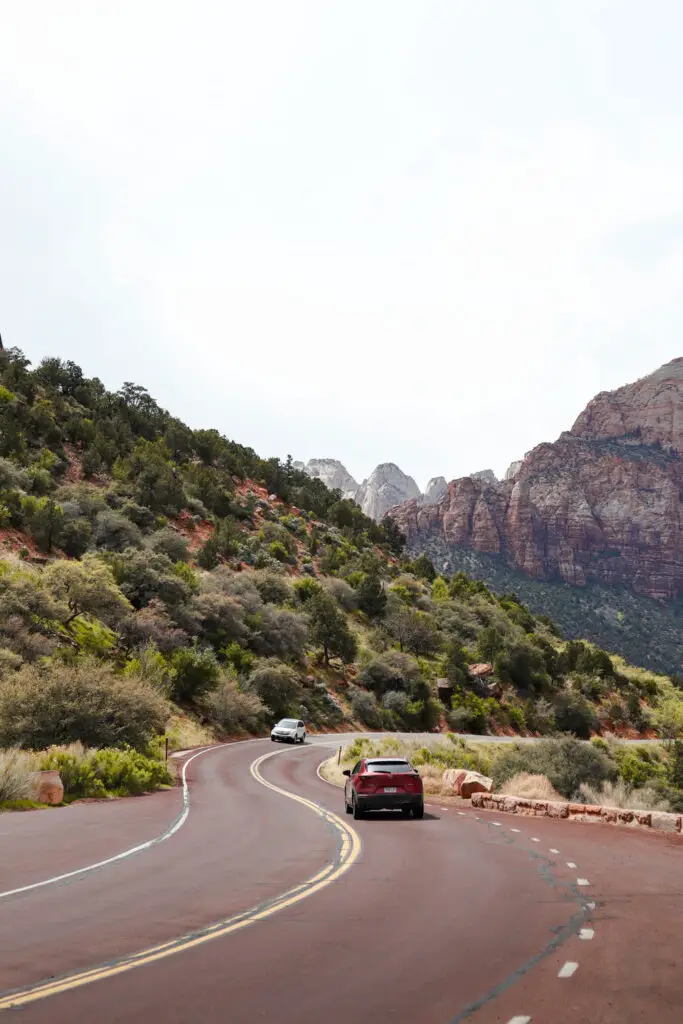
This is the most epic road in the park and you can drive there all year round. The road is full of switchbacks and the landscapes are jaw-dropping. It will be difficult to drive along it without stopping for some photos!

One of the most iconic parts of this road that connects the Springdale entrance to the eastern part of the park is the Zion-Mount Carmel tunnel. This is a tunnel that dates back to the 1930s and is 1.8 kilometres (1.1 mi) long. This tunnel was dug into the mountain and provided a connection between the park, Bryce Canyon and the Grand Canyon, which was impossible until it was built.
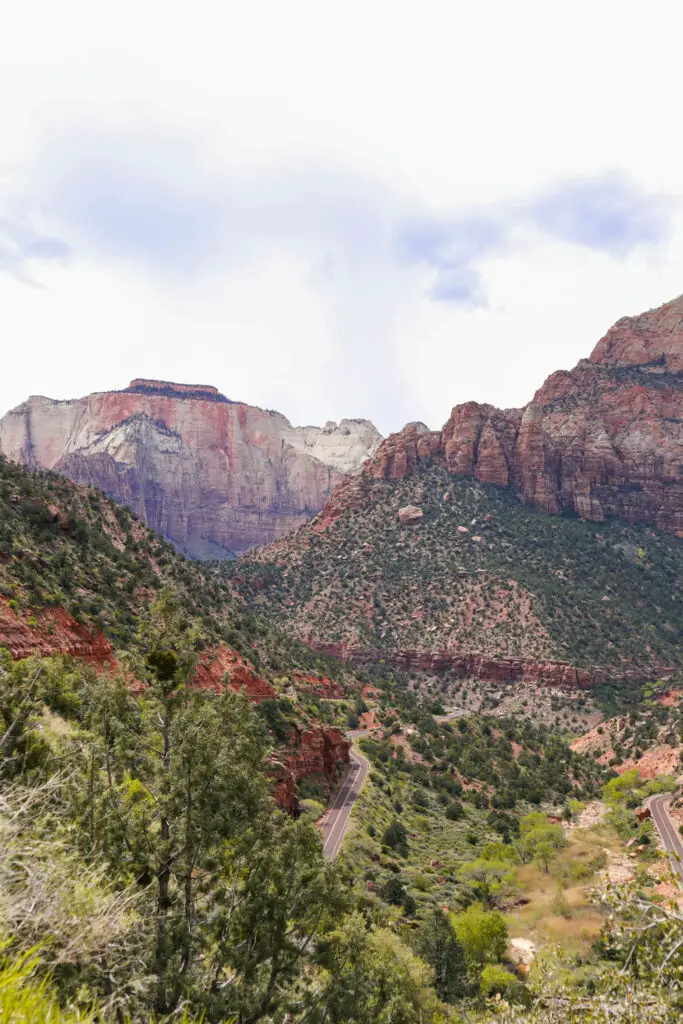
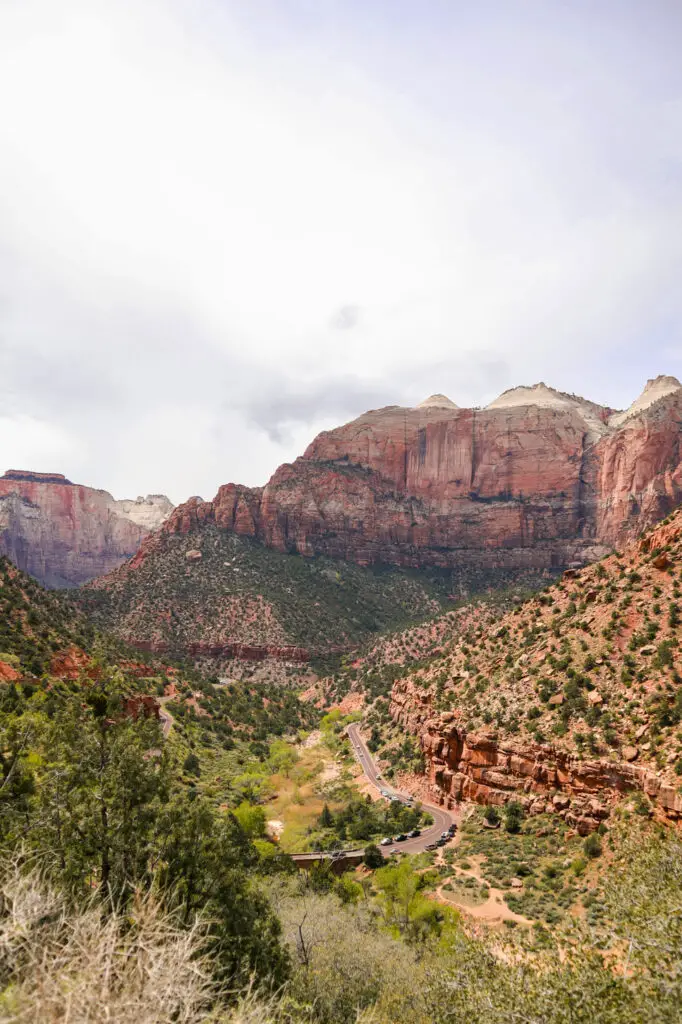
It is not possible to pass through this tunnel on foot or by bicycle, and there are some restrictions for certain types of vehicles. For example, large vehicles (over 2.4 metres wide and 3.4 metres high) must have a licence to pass through the tunnel. The licence costs 15 USD.
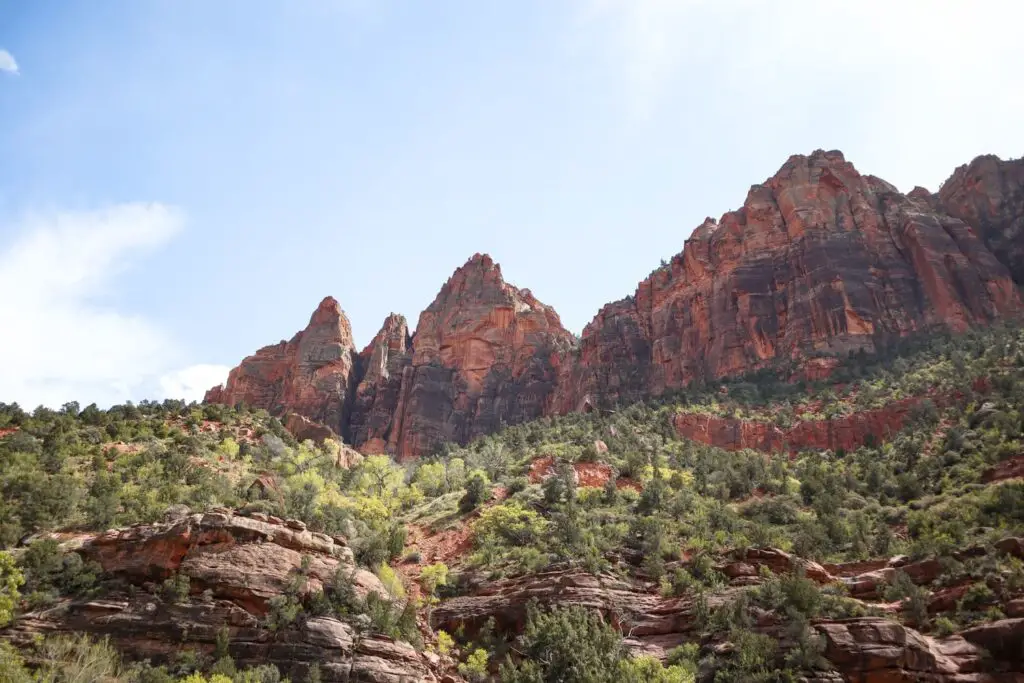
Given the size of the tunnel and its popularity, you sometimes have to wait a while to pass through it as you can only travel in one direction at a time.
» Hike to Canyon Overlook
One day in Zion National Park wouldn’t be complete without visiting one of its best viewpoints – Canyon Overlook.
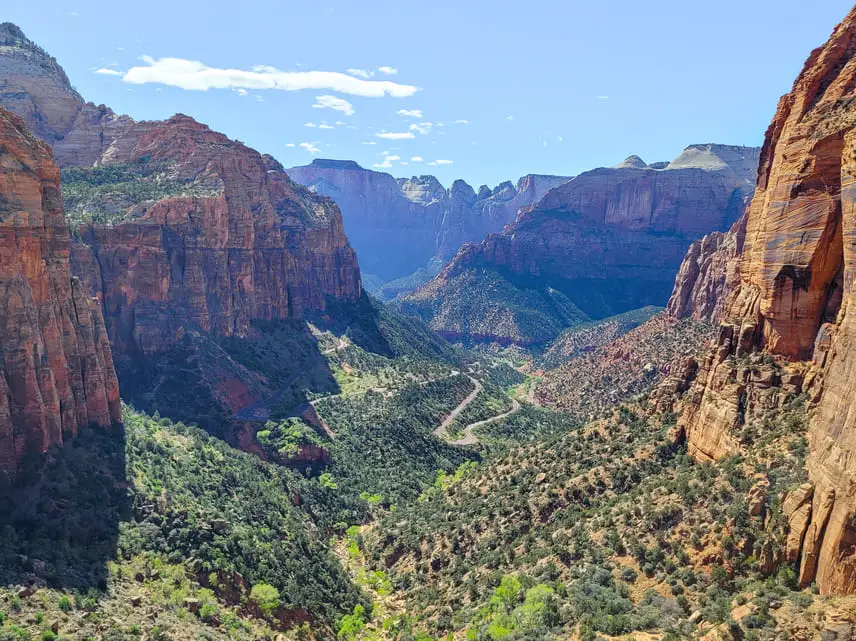
To get to this viewpoint you have to walk along a small hiking trail, that’s moderately easy. But I promise the views at the end will be worth the effort 🥰.
The start of the trail that takes you to Canyon Overlook is located right next to the tunnel on the Zion – Mt Carmel Highway. Parking is scarce and it is common to see cars parked on the side of the road, although this is not permitted.
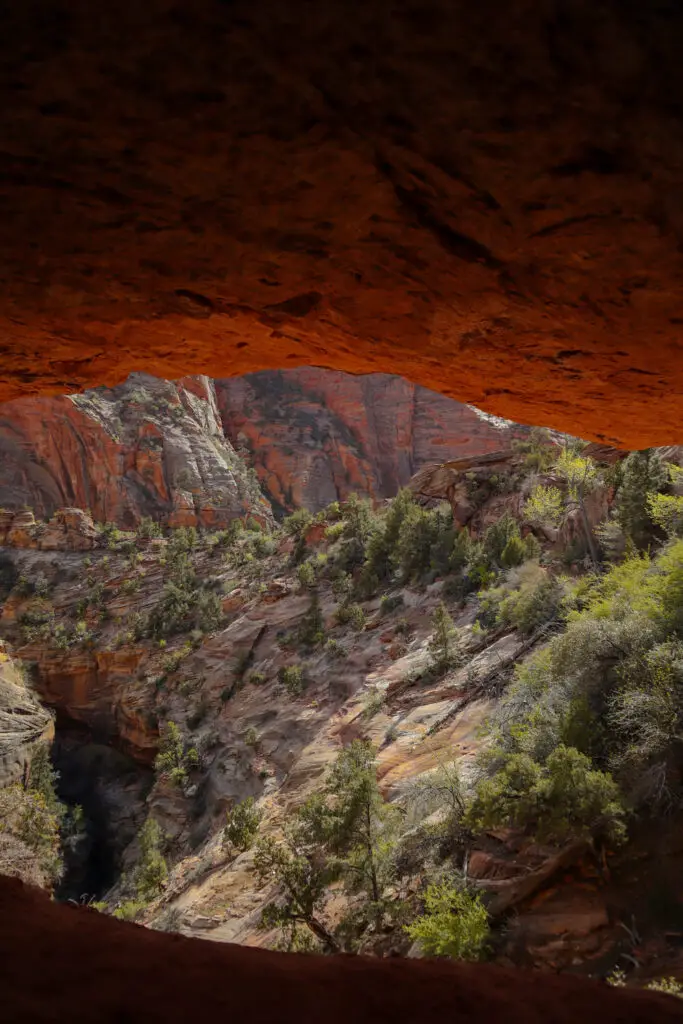

The trail to Canyon Overlook has a few steep parts and the ground is a bit uneven. Moreover, sometimes you need to walk near cliffs without much protection, so you definitely have to be careful. However, I found it a relatively easy trail to walk. And the views at the end are quite something! This is a much easier and quicker alternative to Angels Landing, for example.
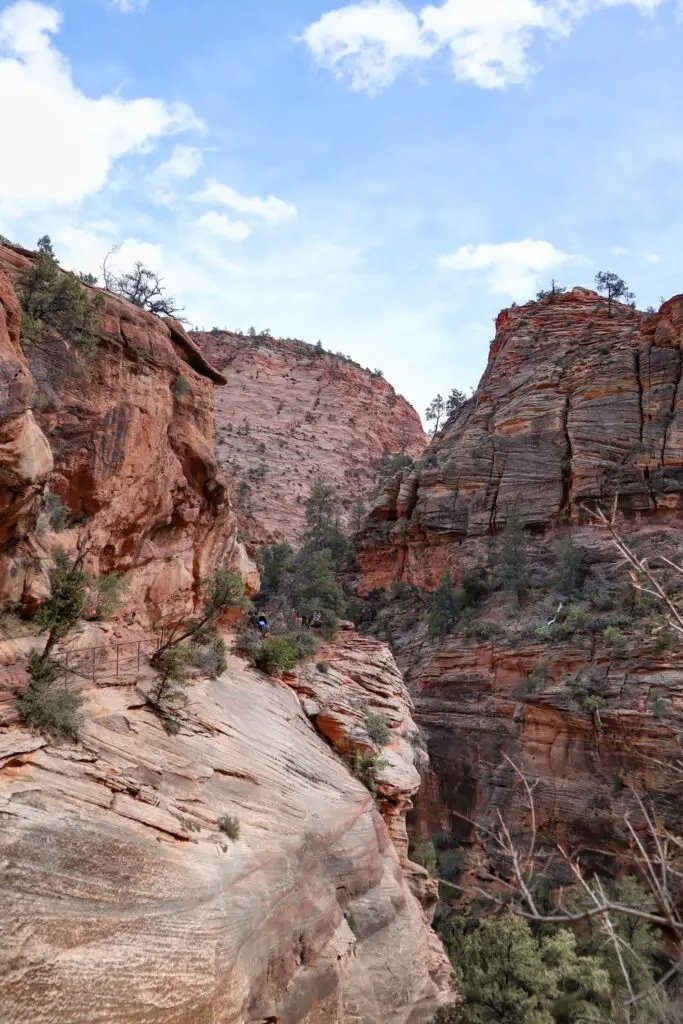
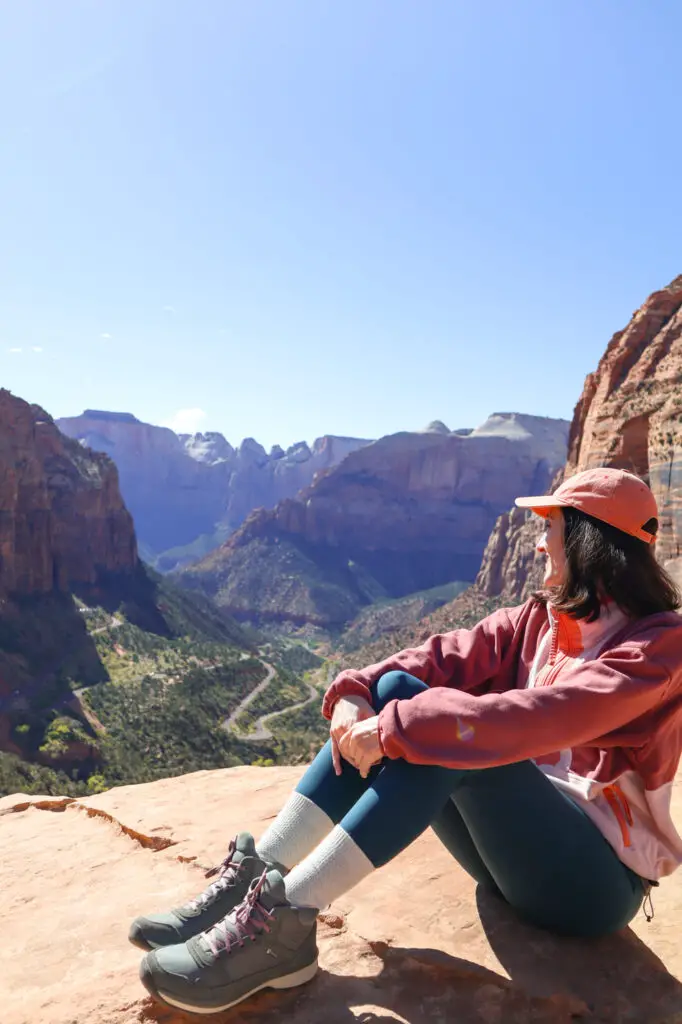
Useful information about the Canyon Overlook trail
- Distance: 1.6 km (1 mi) out and back
- Difficulty: Moderate
- Elevation: 50 m (163 ft)
- Recommended duration: 1h
💡 DICA EXTRA: Read my complete guide to hike the Canyon Overlook trail so you know what to expect.
Itinerary for Zion National Park – What else to see
Although 1 day in Zion National Park is an unforgettable experience, if you have more time to explore the park, I’m sure it will surprise you even more. That’s why I’m sharing some additional suggestions for you to visit in Zion National Park.
Other trails in Zion National Park
| Trail | Shuttle stop | Distance (round trip) | Elevation | Recommended duration |
|---|---|---|---|---|
| The Grotto Trail | #5 (Zion Lodge) | 1.6 km (1 mi) | 11 m (35 ft) | 30 min |
| Weeping Rock Trail (currently closed) | #7 (Weeping Rock) | 0.6 km (0.4 mi) | 30 m (98 ft) | 30 min |
| Watchman Trail | #1 (Visitor Center) | 5.3 km (3.3 mi) | 112 m (368 ft) | 2 hours |
| Sand Bench Trail | #4 (Court of the Patriarchs) | 6.4 km (4 mi) | 142 m (466 ft) | 3 hours |
| Kayenta Trail | #6 (The Grotto) | 3.2 km (2 mi) | 46 m (150 ft) | 1h30 |
| Lower Emerald Pool | #6 (The Grotto) | 3.2 km (2 mi) | 46 m (150 ft) | 1h30 |
| Middle Emerald Pools | #6 (The Grotto) | 3.5 km (2.2 mi) | 45 m (150 ft) | 1h30 |
| Upper Emerald Pool | #6 (The Grotto) | 4.8 km (3 mi) | 61 m (200 ft) | 2 hours |
| The Narrows | #9 (Temple of Sinawava) | 15.1 km (9.4 mi) | 102 m (334 ft) | 8 hours |
| East Mesa Trail | N/A | 10.3 km (6.4 mi) | 61 m (200 ft) | 3h30 |
Although it’s quite a demanding trail, The Narrows is another of the most memorable trails in Zion National Park. It involves crossing parts of the river and hiking this trail gives you a very different perspective of the park. However, given the recommended duration for this trail, it’s only worth doing it if you’re in the park for at least two days.
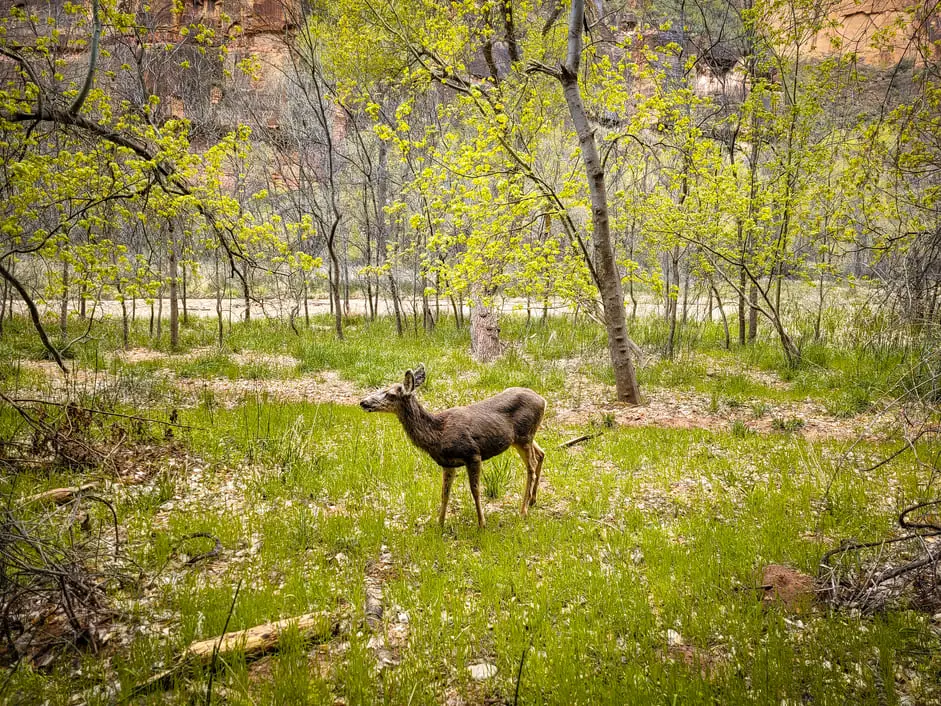
One of the most beautiful viewpoints in Zion National Park is Observation Point and you can only get there by following a trail. However, the main trail is closed indefinitely, so the only way to get there is via the East Mesa Trail, which starts outside the park. The trail itself isn’t that interesting, but the view at the end is rewarding, so it’s worth considering this trail as well.
For the more adventurous, you could also consider the West Rim Trail. This is one of the most demanding trails in the park, but it’s reportedly very worthwhile as it passes through various areas of Zion National Park. This trail can even be turned into a 2-day hike, and on average it takes people between 9 and 12 hours to walk it.
Zion Human History Museum
The Zion Human History Museum is the ideal stop if you want to learn a little more about the people who have lived in this region throughout the years.
Kolob Canyons
Another area of the park, less visited, that is well worth a visit. It also has its Visitor Centre and some trails that are worth considering. Find out more here.
Tips for hiking in Zion National Park
Hiking in Zion National Park is an interesting activity! However, depending on the weather conditions at the time of your visit, some precautions should be taken. These are some of the park’s official recommendations:
- Protect from the sun with a hat, sunglasses, light clothing and sun cream.
- Ensure the necessary hydration while hiking any trail.
- Plan your visit in advance to avoid going on the trails at the hottest time of the day
- In the colder months, it’s important to be prepared for cold temperatures
- On days with fewer hours of daylight, make sure you return from the trail when there is still light since it gets dark earlier
- If you’re going to walk a trail alone, tell someone you know that you’re doing it.
- Plan your return to your car according to the departure time of the last shuttle of the day.
- Make sure you don’t go on any trails without the necessary permits (e.g. Angels Landing)
- Check the official website in advance to confirm any temporary trail closures
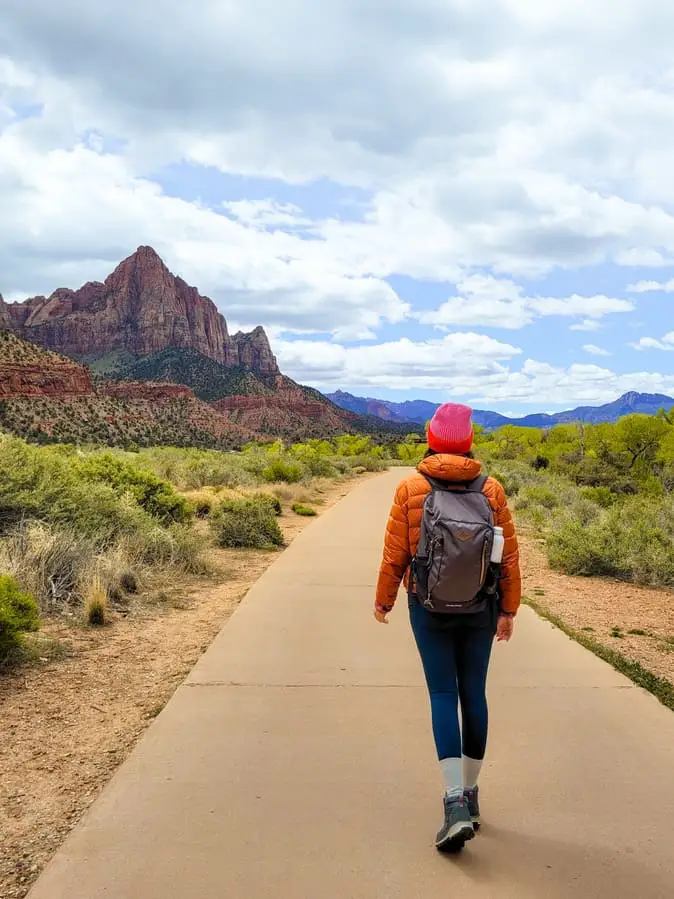
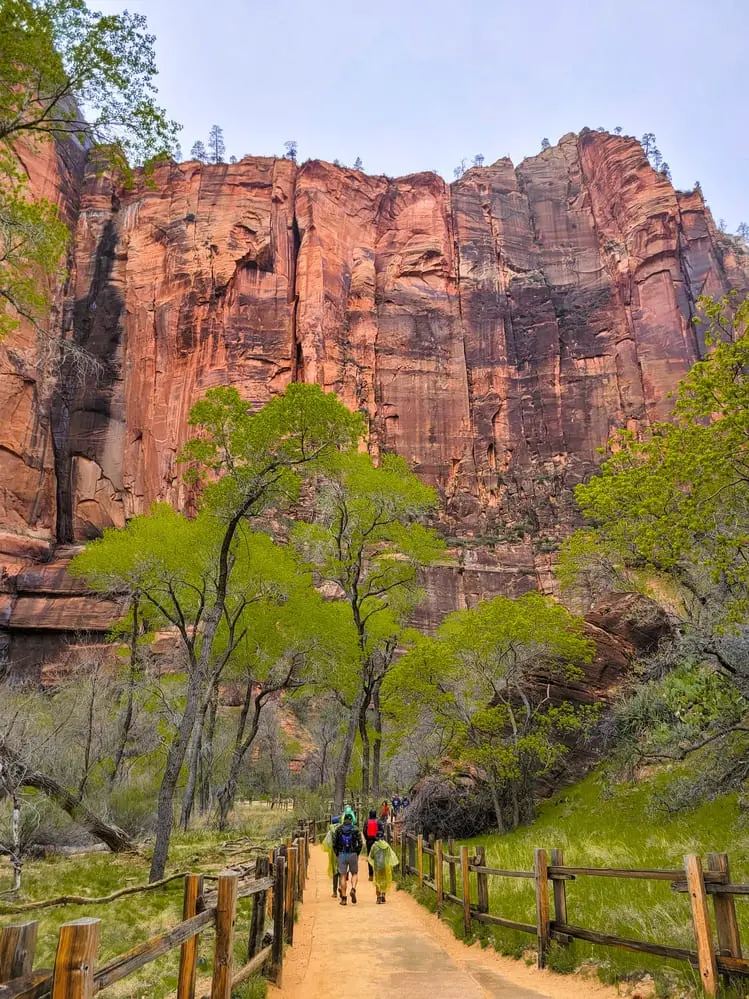
Finally, don’t forget the Leave No Trace principle, by complying with its 7 principles: prepare your visit in advance, dispose of rubbish in appropriate places, leave everything the same way as you found it, minimise the impact of any campfires, respect wildlife, be respectful to other visitors and comply with the camping rules.
Disclaimer: this post may contain some affiliate links, which means I get a small commission if you buy something through my links. This doesn’t represent any additional cost to you and you’ll be supporting my work here on the blog😊


